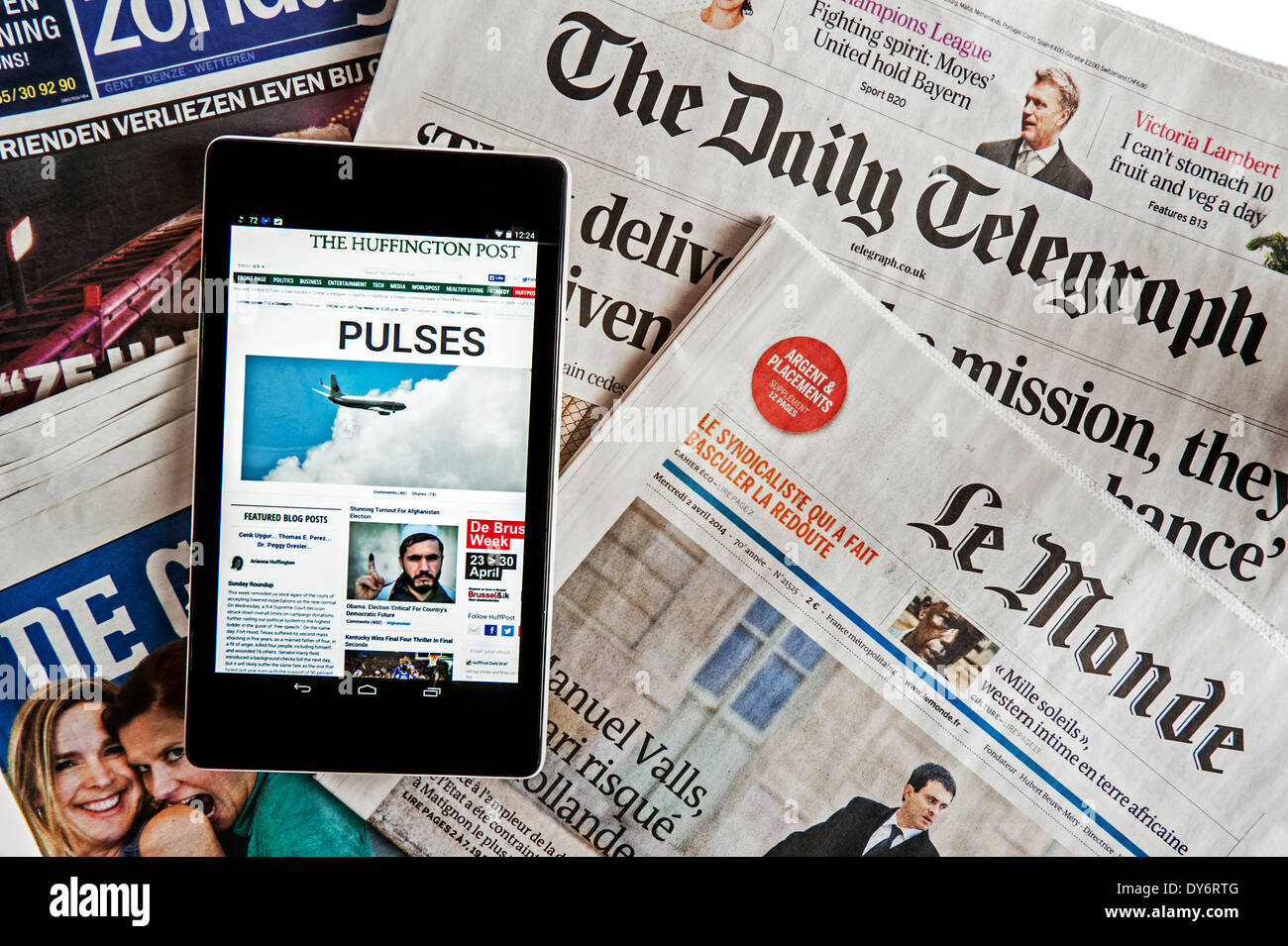The Place of stnews.live in the Online News Ecosystem
Wiki Article
The Influence of Social Media on the Means We Take In News Online
Social media site has actually essentially transformed news consumption. It gives prompt access to details, typically eclipsing conventional media outlets. This fast circulation comes with challenges. Individuals encounter the threat of running into false information and coming to be entraped in resemble chambers. The formulas driving personalized content can cover diverse viewpoints. As these dynamics progress, comprehending their implications comes to be important for notified involvement in public discussion. What techniques might help navigate this complex landscape?The Evolution of News Intake in the Digital Age
As technology progressed, the means people eaten news changed considerably in the electronic age (stnews.live). Traditional newspapers and broadcast media began to decrease as the internet emerged as a main resource of information. Online platforms used immediate accessibility to news write-ups, videos, and podcasts, permitting users to stay notified at any moment. The convenience of mobile devices even more increased this change, making it possible for users to obtain updates on the goIn addition, the rise of news aggregators and sites assisted in the consumption of diverse point of views, empowering individuals to customize their news intake based upon individual rate of interests. This advancement likewise prompted news companies to adjust their approaches, concentrating on digital content and appealing visitors with multimedia styles. Consequently, the standard obstacles of time and room in news distribution diminished, leading to an extra prompt and individualized news experience for audiences worldwide.
The Role of Social Network Platforms in News Distribution
Social media site platforms have actually transformed news distribution by offering instant accessibility to information. Their algorithm-driven content curation typically prioritizes engagement over accuracy, leading to significant reliability obstacles (stnews.live). As customers navigate this landscape, the ramifications for news intake and public discussion ended up being increasingly intricateInstant News Gain Access To
Although conventional news electrical outlets have long been the primary source of info, the surge of social media systems has considerably changed how news is accessed and consumed. Instantaneous news gain access to has actually become a trademark of the digital age, making it possible for users to get updates in genuine time. Platforms such as Twitter, Facebook, and Instagram allow news to spread swiftly, usually going beyond traditional media in speed and reach. Users can share stories, comment on occasions, and engage with journalists, creating a vibrant interaction in between the audience and news web content. This immediacy fosters a society of urgency, triggering individuals to inquire swiftly. The expectation for prompt news has actually improved journalistic practices, compelling news organizations to adjust their approaches to meet the demands of a busy digital environment.Algorithm-Driven Material
While customers proactively involve with material on social networks, the formulas that govern these systems play a crucial role in determining which newspaper article obtain visibility. These algorithms analyze individual habits, preferences, and involvement metrics to curate individualized news feeds. Because of this, specific tales may be magnified while others stay obscure, often prioritizing marvelous or trending topics over substantive reporting. This careful exposure forms customers' perceptions of current occasions and affects public discourse. In addition, the reliance on algorithm-driven material can create echo chambers, where individuals are mainly subjected to perspectives that align with their own ideas. The dynamics of news circulation on social media platforms significantly influence just how individuals consume and analyze information in the digital age.Reputation Challenges
As users progressively turn to social media for news, the trustworthiness of info encountered on these systems ends up being a pressing concern. The decentralized nature of social media sites allows anybody to publish web content, often blurring the lines in between reliable journalism and misinformation. Algorithms focus on engagement over precision, leading to the widespread dissemination of marvelous or deceptive tales. This setting postures significant difficulties for individuals trying to discern reliable sources. Social network platforms, while striving to combat misinformation via fact-checking and content moderation, face objection for inconsistencies and prejudices in their strategies. Inevitably, the duty exists with users to seriously examine the news they eat, as the fast spread of details typically exceeds confirmation initiatives by systems.The Rise of Person Journalism and User-Generated Content
The rise of citizen journalism has equipped daily people to share news and viewpoints, usually giving insights that standard media may overlook. This change also offers substantial obstacles, particularly the spread of false information that can develop from unverified web content. As user-generated content ends up being extra common, the equilibrium between authentic voices and accuracy in reporting stays a crucial concern.Encouraging Daily Voices

Difficulties of Misinformation
While the increase of citizen journalism has opened up avenues for varied voices in the media landscape, it has additionally presented considerable challenges connected to false information. The simplicity of sharing info with social media sites platforms permits individuals to distribute news promptly, but this fast spread typically comes with the price of accuracy. User-generated web content regularly does not have the strenuous fact-checking and editorial oversight that conventional journalism gives. Consequently, sensationalized or false stories can gain grip, misdirecting audiences and shaping public understanding (stnews.live). The mixing of opinion and fact within social media complicates the difference between legitimate information and misinformation. As an outcome, customers must discover this info here browse a progressively complex media setting, calling for crucial thinking abilities to determine trusted news resources in the middle of the sound
Misinformation and Its Implications for Public Discourse
As social media sites platforms progressively control the landscape of details dissemination, the expansion of false information poses significant obstacles for public discourse. False information, often designed to deceive or provoke emotional feedbacks, can distort assumptions of truth and threaten trust fund in reliable sources. This sensation causes polarized viewpoints, as individuals move towards echo chambers that strengthen their ideas, even more lodging departments within culture.The ramifications for public discourse are profound. When residents depend on incorrect information, meaningful discussion diminishes, and the democratic procedure suffers. Misinformation can incite anxiety and confusion, impacting public health and wellness, safety and security, and political security. Therefore, promoting media literacy ends up being necessary, equipping people to seriously assess details and determine reality from fiction. Addressing the obstacles positioned by misinformation is vital for maintaining the stability of public discussion and making sure an educated people with the ability of taking part in useful discussions.
The Influence of Formulas on News Exposure
Offered the main function of algorithms in identifying material visibility, their influence on news consumption is profound. These algorithms, used by social media sites systems, focus on certain types of material based on customer involvement and choices. As an outcome, news write-ups that align with popular fads or audience interests are extra most likely to be shown prominently, while less marvelous tales might be forgotten. This produces a setting where customers are revealed mostly to details that enhances their point of views, potentially resulting in echo chambers.The continuous advancement of algorithms means that news companies need to adapt their methods to align with these transforming criteria, often focusing on clickbait or psychologically billed headlines. Subsequently, the honesty of news coverage can be compromised, as vital tales may not get the exposure they are entitled to. The algorithmic shaping of news visibility therefore plays an essential function in influencing public perception and understanding of current events.
The Shift Toward Visual Narration in News Media
Increasingly, news media is welcoming visual narration as a powerful device to involve target markets. This method leverages pictures, videos, infographics, and interactive elements to share details better than traditional text-based layouts. As interest spans reduce, visuals supply a quick, impactful means to communicate intricate tales and order audiences' passion.Platforms like Instagram and TikTok have additional accelerated this fad, engaging wire service to adapt their material approaches to fit these visually-driven atmospheres. By including compelling visuals, news electrical outlets can boost psychological links and foster better understanding of topical issues.
Furthermore, visual narration permits for even more varied stories, showcasing numerous viewpoints via dynamic discussions. As audiences progressively consume news via mobile phones, the change toward visuals Discover More Here not just satisfies individual preferences but additionally aids go to my blog to break down barriers to info accessibility. Eventually, this evolution reflects a broader change in how news is produced and eaten in the digital age.
Future Patterns: Browsing the Altering Landscape of News Intake
While the digital landscape continues to develop, news consumption is positioned for significant makeover driven by arising innovations and altering audience habits. As synthetic knowledge and artificial intelligence advance, individualized news feeds will certainly end up being much more widespread, allowing customers to get material tailored to their interests. This personalization can result in greater interaction but also raise issues concerning resemble chambers and misinformation.The surge of voice-activated gadgets and smart speakers will affect exactly how news is supplied, changing the emphasis from aesthetic to auditory layouts. This pattern may motivate news companies to adopt even more succinct and engaging audio material.

Regularly Asked Inquiries
Just How Do Social Media Interactions Affect News Reliability?
Social media communications can significantly influence assumptions of news credibility. Involvement metrics, such as likes and shares, often form audience depend on, with popular articles obtaining viewed legitimacy, despite the accuracy or reliability of the details offered.What Role Do Influencers Play in Shaping News Narratives?
Influencers greatly form news narratives by leveraging their systems to amplify specific tales, frequently tailoring content to their target market. This can cause prejudiced point of views, affecting public assumption and prioritizing sensationalism over valid coverage.How Can Users Identify Reliable News Resources on Social Network?
Customers can determine dependable news resources on social networks by inspecting the source's credibility, verifying realities through multiple outlets, examining the expertise of the material, and acknowledging potential prejudices in reporting to ensure exact details.What Effect Does Social Media Site Carry Standard Journalism Jobs?
Social media greatly affects traditional journalism tasks by changing revenue models, decreasing demand for print media, and cultivating competitors from citizen reporters. Consequently, many experts encounter job instability and have to adapt to rapidly changing media landscapes.Exactly How Do Different Demographics Consume News on Social Media?
Various demographics show different preferences for news usage on social media. Younger audiences prefer platforms like TikTok and Instagram for fast updates, while older people tend to choose Twitter and facebook for extra in-depth conversations and posts.Report this wiki page